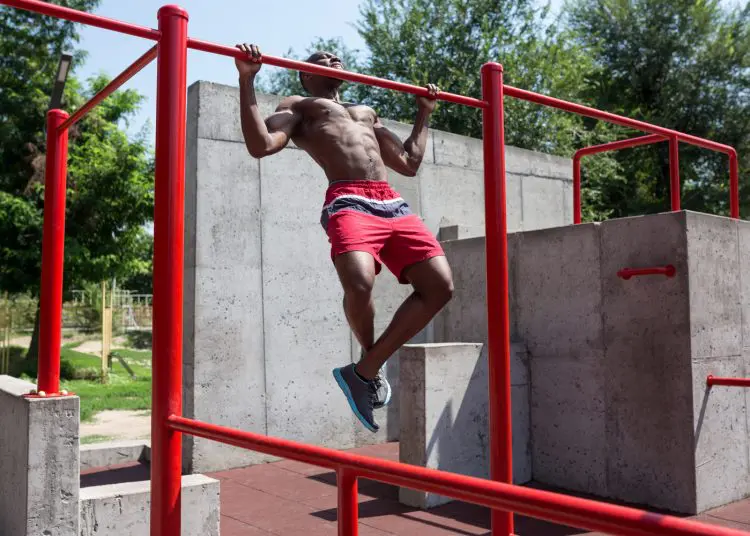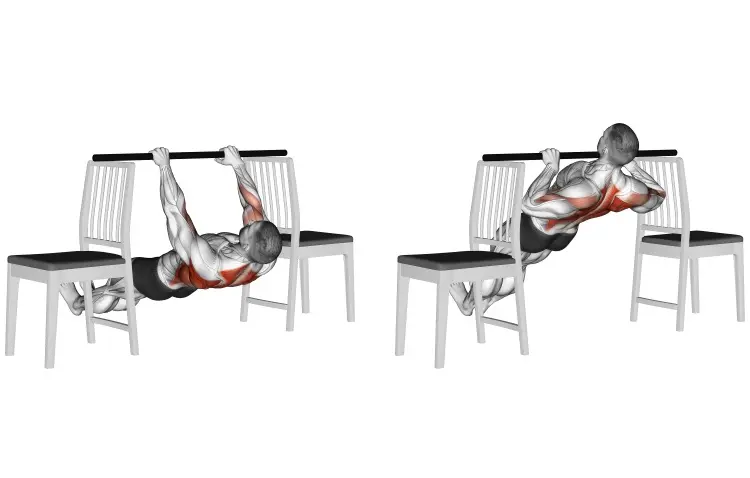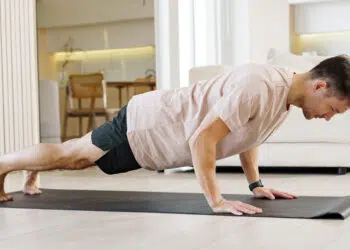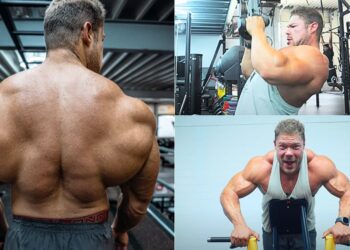Unless you’ve got a really well-equipped garage gym, your choice of home workout exercises is probably quite limited. In fact, you may find yourself doing nothing but push-ups, sit-ups, and lunges.
That’s not to say there is anything wrong with these particular exercises, but if that’s all you do, your workouts will soon start to get stale, and you may develop muscle imbalances. The good news is that you can do plenty of other great exercises.
As a seasoned personal trainer with over 35 years of experience, I’ve helped hundreds of people transform their backs with home-friendly exercises using no or minimal equipment.
In this article, I’ll reveal the 15 best back exercises you can do at home.
Recent Updates: On July 11, 2024, Fitness Volt’s Senior Editor Vidur Saini (American Council on Exercise-CPT) updated the article and added actionable expert tips throughout the piece to improve the reader experience. Level Up Your Fitness: Join our 💪 strong community in Fitness Volt Newsletter. Get daily inspiration, expert-backed workouts, nutrition tips, the latest in strength sports, and the support you need to reach your goals. Subscribe for free!
15 Best At-Home Back Exercises
For this list of best at-home back exercises, we’ve made a few assumptions:
- You’ve got access to dumbbells or makeshift weights such as water bottles
- Or resistance bands
- You have somewhere you can do pull-ups
- Access to a sturdy elevated surface for incline rows
You don’t need all of these things to have a great back workout at home, but you’ll need at least one of them to train these all-important muscles.
So, in no particular order, here are the 15 best back exercises you can do at home!
- Pull-Ups Or Chin-Ups
- Inverted Rows
- Bent Over Two-Handed Dumbbell Row
- Dumbbell Wrestler’s Row
- Single-Arm Dumbbell Row
- Dumbbell Pendlay Row
- Kroc Rows
- Dumbbell Yates Row
- Renegade Row
- Seated Resistance Band Row
- Bent Over Resistance Band Row
- Standing Resistance Band Row
- Resistance Band Lat Pulldowns
- Band Pull Aparts
- Skydivers
1. Pull-ups or Chin-ups
| Sets & Reps | 3 x 8-12 (or to failure) |
| Equipment Needed | Pull-up bar |
| Target Muscles | Lats, biceps, forearms |
If you have a pull-up bar, you have access to one of the best back-building tools around. Pull-ups and chin-ups are challenging, but they are great for increasing back strength and mass. They’re also useful biceps exercises.
Pull-ups are done using an overhand grip slightly wider than shoulder-width, while chin-ups are done with a narrower, underhand grip. These two exercises are largely interchangeable, so try them both and see which one you prefer.
Pro Tip: Activate your lats before initiating the pull by depressing your scapula (imagine pulling your shoulder blades down and into your back pockets).
| Difficulty | Intermediate/Advanced |
| Progression | Weighted pull-ups/chin-ups, slower negatives, one-arm variations |
| Regression | Assisted pull-ups/chin-ups (resistance band or machine), negatives |
Read all about these excellent exercises in our detailed guide.
2. Inverted rows
| Sets & Reps | 3 x 10-15 |
| Equipment Needed | Smith machine or TRX straps/rings, bar (or sturdy table) |
| Target Muscles | Lats, rhomboids, biceps, rear deltoids |
Whether you are not quite strong enough to do pull-ups or chin-ups yet or just want to broaden your bodyweight back workout repertoire, inverted rows are the exercise for you. Done with your feet on the floor, inverted rows are considerably easier than pull-ups, but they work many of the same muscles.
You can do inverted rows using a suspension trainer, such as a TRX, by placing a strong broomstick between two tall chairs or even by lying beneath a table.
Pro Tip: Pause for a split second at the top of each rep and squeeze your shoulder blades together to maximize lat contraction.
| Difficulty | Beginner/Intermediate |
| Progression | Increase incline (feet higher), weighted inverted rows |
| Regression | Decrease incline (feet lower) |
Learn how to do this exercise here.
3. Bent over two-handed dumbbell row
| Sets & Reps | 3 x 8-12 |
| Equipment Needed | Dumbbells |
| Target Muscles | Lats, rhomboids, traps, biceps, rear deltoids |
Except for pull-ups, most at-home back exercises involve some sort of rowing motion. That’s no bad thing because, as well as working your lats, rows also work your middle traps and rhomboids.
The bent-over two-handed dumbbell row is an excellent exercise if you don’t have access to a barbell. It’s a little easier on your lower back than the barbell version but no less effective.
Pro Tip: Initiate the row by pulling with your elbows, not your hands. Visualize dragging your elbows towards your hips, emphasizing scapular retraction for optimal lat activation.
| Difficulty | Beginner |
| Progression | Barbell row |
| Regression | Resistance band rows |
Check out this guide to see how to do this exercise correctly.
4. Dumbbell wrestler’s row
| Sets & Reps | 3-4 x 15-20 (each arm) |
| Equipment Needed | Dumbbell |
| Target Muscles | Lats, rhomboids, traps, biceps, obliques |
This bent-over row variation is ideal when you don’t have a lot of weight to train with. Your upper back is under constant tension, so you can get a great workout even if you only have light dumbbells or a pair of water bottles for your workouts.
“This exercise is a brutal but effective way to build grip strength and target the lats from a unique angle,” says Saini.
How to do it:
- Hold a weight in both hands, bend your knees, and lean forward, so your upper body is roughly parallel to the floor. Do not round your lower back. Brace your abs and pull the weights up and into your sides with your upper arms tucked in.
- Extend one arm and lower the weight. Row it back in.
- Next, extend the other arm and then row it back in.
- Keep alternating arms until you have done the required number of reps.
Pro Tip: Limit wrist supination during this exercise to minimize bicep recruitment and focus on the lats.
| Difficulty | Intermediate |
| Progression | Barbell row |
| Regression | Conventional dumbbell row |
5. Single-arm dumbbell row
| Sets & Reps | 3 x 8-12 (each arm) |
| Equipment Needed | Dumbbell, bench |
| Target Muscles | Lats, rhomboids, traps, biceps, rear deltoids |
The single-arm dumbbell row is a bodybuilding classic. Because one arm is free to support the lower back, it allows one to train in relative comfort and avoid lower back pain.
This dumbbell exercise can also be done using a resistance band. Just anchor the band under your foot.
Pro Tip: To prevent torso rotation and maximize core stability, actively brace your core by contracting your abs and obliques as if you’re about to be punched in the stomach.
| Difficulty | Intermediate |
| Progression | Pendlay row |
| Regression | Resistance band row |
Find out how to do single-arm dumbbell rows here.
6. Dumbbell Pendlay row
| Sets & Reps | 3 x 6-8 |
| Equipment Needed | Dumbbells |
| Target Muscles | Lats, rhomboids, traps, biceps, rear deltoids, glutes, hamstrings |
Pendlay rows, also known as dead-stop rows, are named after Olympic weightlifting and powerlifting coach Glen Pendlay. They involve resting your weights on the floor between reps, which eliminates momentum and also gives your lower back and grip a brief rest. Generally done with a barbell, you can also do this move with dumbbells for a great upper back exercise at home.
Pro Tip: Explosively pull the dumbbell off the floor but lower it under control, emphasizing a strong eccentric contraction (negative) to maximize muscle damage and growth potential.
| Difficulty | Intermediate |
| Progression | Barbell Pendlay row |
| Regression | Bent-over dumbbell row, single-arm dumbbell row |
Read all about Pendlay rows in this in-depth guide.
7. Kroc rows
| Sets & Reps | 3-4 x 15-20 (each arm) |
| Equipment Needed | Dumbbell |
| Target Muscles | Lats, rhomboids, traps, biceps, obliques |
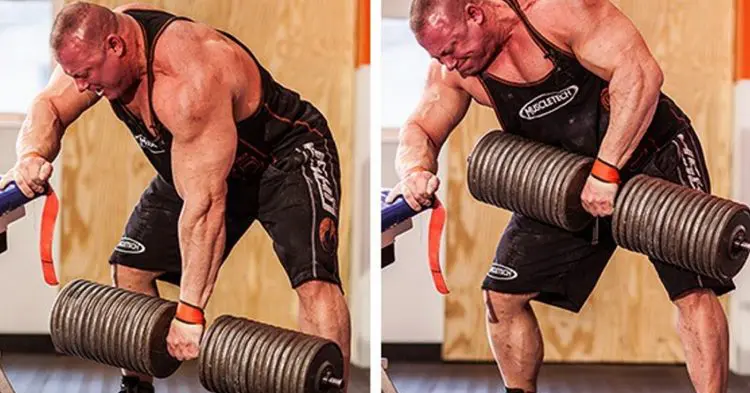
Named after powerlifter and bodybuilder Janae Kroc, Kroc rows are an intense exercise designed to build muscle size and strength.
You’ll need a heavy weight for this exercise, but if you’ve got access to a big dumbbell and want to train like a beast, it should appeal to you.
Pro Tip: Focus on maintaining a neutral spine throughout the movement by bracing your core and avoiding excessive hip extension to protect your lower back and allow you to focus on working the lats.
| Difficulty | Intermediate |
| Progression | Increase dumbbell weight |
| Regression | Conventional dumbbell row |
Learn more about Kroc Rows: Muscles Worked, Benefits, How-to, and Alternatives.
8. Dumbbell Yates row
| Sets & Reps | 3 x 8-12 |
| Equipment Needed | Dumbbells |
| Target Muscles | Lats, rhomboids, traps, biceps, rear deltoids |
The Yates row is named after bodybuilding legend Dorian Yates. Where most bent-over row exercises involve a lot of forward lean, Yates row uses a much more forgiving torso angle.
According to Yates, this means you are free to focus on working on your lats without overloading your lower back. And who are we to argue? Dorian Yates had one of the best backs in the history of bodybuilding.
Pro Tip: Lean forward slightly from the hips to create a greater stretch in the lats at the bottom of the movement. This increased range of motion can lead to greater muscle growth over time. Level Up Your Fitness: Join our 💪 strong community in Fitness Volt Newsletter. Get daily inspiration, expert-backed workouts, nutrition tips, the latest in strength sports, and the support you need to reach your goals. Subscribe for free!
Yates rows are usually done using a barbell, but they work equally well with dumbbells. Learn how to do them here.
| Difficulty | Beginner |
| Progression | Increase weight, use barbell |
| Regression | Conventional dumbbell row |
9. Renegade row
| Sets & Reps | 3 x 8-12 (each arm) |
| Equipment Needed | Dumbbells |
| Target Muscles | Lats, rhomboids, traps, biceps, rear deltoids, core |
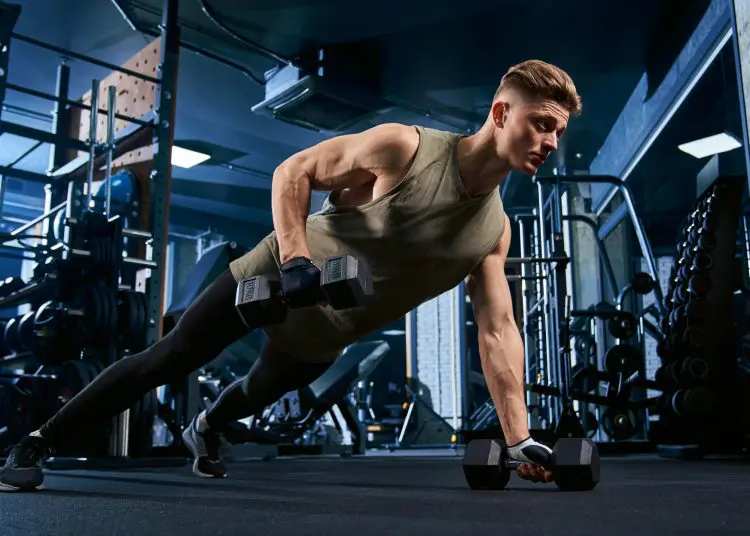
Renegade rows are part back exercise and part core exercise. In fact, with a simple addition, you can use this exercise to work your chest and triceps too. All in all, it’s a very efficient at-home back exercise, and all you need is a pair of dumbbells.
Saini adds that this is a challenging exercise that combines upper-body pulling with core stability for a full-body burn.
How to do it:
- Hold a dumbbell in each hand, and then get into the push-up position with your arms, legs, and body straight. Brace your abs.
- Bend one arm and row your dumbbell up and into your ribs.
- Put the dumbbell back on the floor and do another rep on the opposite side.
- Alternate arms for the duration of your set.
- Do a push-up between reps to turn this at-home back exercise into an all-around upper-body workout.
Pro Tip: As you row the dumbbell, actively drive your opposite hand into the ground to enhance core stability and prevent your hips from rotating.
| Difficulty | Intermediate |
| Progression | Perform push-up between rows |
| Regression | Standard dumbbell row |
10. Seated resistance band row
| Sets & Reps | 3 x 12-15 |
| Equipment Needed | Resistance band |
| Target Muscles | Lats, rhomboids, traps, biceps, rear deltoids |
You can replicate most bodyweight and machine exercises with a resistance band or two. Resistance band exercises are often more joint-friendly, too, as there is no inertia to overcome at the start of each rep. This band exercise is a good alternative to cable seated rows.
How to do it:
- Sit on the floor with your legs extended out in front of you. Sit up tall with your back straight and core braced.
- Loop your band over your feet and hold an end in each hand.
- Bend your arms and pull your hands into the sides of your abdomen.
- Extend your arms and repeat.
- Maintain good posture throughout.
Pro Tip: Anchor the band slightly higher than usual to increase the line of pull and emphasize the upper back muscles (traps and rhomboids).
| Difficulty | Beginner |
| Progression | Use a stronger resistance band, increase time under tension |
| Regression | Use a lighter resistance band |
11. Bent-over resistance band row
| Sets & Reps | 3 x 12-15 |
| Equipment Needed | Resistance band |
| Target Muscles | Lats, rhomboids, traps, biceps, rear deltoids |
Bent-over rows are traditionally done using a barbell or dumbbell, but you can also perform this exercise using a resistance band.
Bent-over rows put a little more stress on your lower back than the seated variation, but providing you have no back problems, that could actually help increase the strength of your erector spinae muscles.
“A convenient and versatile exercise that can be done anywhere, perfect for travel or at-home workouts,” says Saini.
How to do it:
- Stand on the center of your band, feet about shoulder-width apart. Take a handle in each hand. Bend your knees slightly and bend over, so your torso is about parallel to the floor. Do not round your back.
- Bend your arms and pull your hands up and into your lower ribs.
- Extend your arms and repeat.
- You could also lean over a little less, making this a Yates resistance band row.
Pro Tip: Stagger your feet (one foot forward, one foot back) to provide a more stable base and reduce stress on your lower back.
| Difficulty | Beginner |
| Progression | Use stronger resistance band, single-arm variation |
| Regression | Seated variation |
12. Standing resistance band row
| Sets & Reps | 3 x 12-15 |
| Equipment Needed | Resistance band |
| Target Muscles | Lats, rhomboids, traps, biceps, rear deltoids |
It’s useful to know lots of variations of the same exercise. That way, your workouts never need to be boring. This rowing variation is a good alternative to seated and bent-over resistance band rows. It’s every bit as effective, but doing it while standing could help ward off workout boredom.
How to do it:
- Attach your resistance band to a waist-high anchor. Take an end in each hand and step back to tension your band. Brace your abs.
- Bend your arms and pull your hands into the side of your ribs. Keep your elbows tucked in and your wrists straight.
- Extend your arms and repeat.
Pro Tip: Instead of pulling the band straight towards your chest, try pulling it diagonally towards your hip. This variation targets the lats from a slightly different angle, promoting more balanced development.
| Difficulty | Beginner |
| Progression | Bent over resistance band row |
| Regression | Seated variation |
13. Resistance band lat pulldowns
| Sets & Reps | 3 x 12-15 |
| Equipment Needed | Resistance band |
| Target Muscles | Lats, biceps |
Training at home doesn’t have to mean you can’t do lat pulldowns. In fact, if you’ve got a resistance band and a suitable high anchor point, you have everything you need to do this popular back builder.
How to do it:
- Attach your resistance band to a strong overhead anchor. Take the band in your hands and then kneel down with your arms extended overhead.
- Bend your arms and pull your hands down to the front of your shoulders.
- Extend your arms and repeat.
- You can also do this exercise one-handed, which may be necessary if you only have a light band to train with.
Pro Tip: Vary your grip width to target different areas of the lats. A wider grip emphasizes the outer lats, while a narrower grip focuses on the inner lats.
| Difficulty | Beginner |
| Progression | Use a stronger resistance band, kneel, or stand for increased tension |
| Regression | Straight arm banded lat pulldown |
14. Band pull aparts
| Sets & Reps | 3 x 15-20 |
| Equipment Needed | Resistance band |
| Target Muscles | Rear deltoids, rhomboids, middle traps |
Band pull-aparts are one of the few back exercises that don’t involve your biceps. Instead, this move emphasizes your middle traps, rhomboids, and posterior deltoids, making it a great exercise for better posture.
Saini highlights that this is an essential exercise for shoulder health and maintaining proper posture, especially for those who spend a lot of time sitting.
Pro Tip: Focus on keeping your shoulders down and back as you perform the pull apart. This will protect your rotator cuff and ensure that you’re primarily working the rear deltoids and mid-traps.
| Difficulty | Beginner |
| Progression | Use a thicker resistance band, increase reps |
| Regression | Lighter resistance band |
Check out our in-depth guide to find out more about this fantastic at-home upper back exercise.
15. Skydivers
| Sets & Reps | 3 x 15-20 (hold for 2-3 seconds at the top) |
| Equipment Needed | None (bodyweight) |
| Target Muscles | Rear deltoids, rhomboids, middle traps, erector spinae |
No gym equipment? No problem! You can still get a half-decent back workout at home using nothing but your body weight. While this move won’t work your lats much, it does work your erector spinae, mid-traps, and rhomboids.
It’s an excellent postural exercise and the perfect antidote for long periods of sitting.
Saini recommends this challenging exercise as it strengthens the postural muscles and improves core stability.
How to do it:
- Lie on your front with your legs straight and your palms flat on the floor on either side of your head.
- Lift your legs, head, chest, and arms a few inches off the floor. Pull your shoulders down and back.
- Hold this position for a couple of seconds.
- Lower your legs and upper body back down and repeat.
- Do not arch too high; hyperextending your lumbar spine could cause lower back pain.
Pro Tip: Visualize squeezing a pencil between your shoulder blades as you perform the exercise. This mental cue will help you activate the correct muscles and maximize the effectiveness of the movement.
| Difficulty | Beginner |
| Progression | Hold for longer duration, elevate feet |
| Regression | Use a limited range of motion |
At-Home Back Workout
Not sure where to start with your home back workout? Don’t worry; we’ve got you covered! Do the following training program 1-2 times per week. If you do it twice, make sure you allow a few days for recovery and muscle growth, e.g., Monday and Thursday.
Before you start working out, remember to warm up. A thorough warm-up will reduce your risk of injury and increase the effectiveness of your workout.
Jog or jump rope for 5-10 minutes and then do a few joint mobility and dynamic flexibility exercises for the body parts you are about to train. Pay extra attention to your lower back. Finish your warm-up with a few light sets of the first 1-2 exercises of the workout.
If possible, adjust your weights, reps, and rest between sets to your training goals, i.e.;
| Training Goal | Endurance | Hypertrophy | Strength/Power |
| Intensity | Low | Moderate | High |
| Load | <67% of 1RM | 67-85% of 1RM | >85% of 1RM |
| 1RM = 1-repetition maximum and is the maximum amount of weight that can be lifted once but not twice | |||
| Repetitions per set | 13-20 | 6-12 | 1-5 |
| Recovery between sets | 30-60 seconds | 1-2 minutes | 3-5 minutes+ |
However, if that’s not practical, just take each set to muscular failure, which is the point at which you are unable to do more reps using perfect form.
| Exercise | |
| 1 | Pull-ups/chin-ups |
| 2 | Single-arm dumbbell rows |
| 3 | Resistance band lat pulldowns |
| 4 | Standing resistance band rows |
| 5 | Skydivers |
Back Anatomy
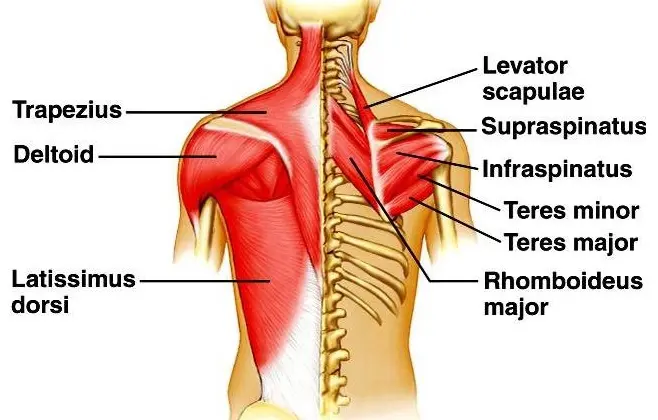
While you don’t need to know the names of the muscles you are training, it can be helpful when it comes to designing your own bodybuilding workouts. That way, you can make sure you are targeting the right part of your back.
The main muscles that make up your back are:
Latissimus dorsi
This is the largest of your upper back muscles. Known as your lats for short, when well developed, they look not unlike a pair of wings. Located on the side of your upper back, the lats adduct and extend your shoulders.
Trapezius
The traps are a large diamond-shaped muscle that covers your upper back. There are three sets of fibers, and each one has a different function. The upper traps elevate your shoulder girdle, the middle traps pull your shoulders back and together, and the lower traps depress your shoulder girdle.
Rhomboids
This small muscle is located between your shoulder blades. The rhomboids work with your mid traps to retract your shoulder girdle and are also involved in shoulder elevation.
Erector spinae
This is the collective name for the muscles that run up either side of your spine. They extend your spine and prevent it from rounding during exercises like seated and bent-over rows.
Posterior deltoids
While not strictly a back muscle, the posterior deltoids are on the rear of your body and are involved in most home back exercises. The deltoids are your shoulder muscles, and the posterior delts work with your lats to extend your shoulders.
Wrapping Up
Training at home can often feel limiting, but it doesn’t have to be. Sure, you may not have access to things like pulley machines and barbells, but that doesn’t mean you can’t build a back to be proud of.
Ultimately, your body cannot differentiate between doing pulldowns using a state-of-the-art lat pulldown machine and doing pull-ups from a tree branch. It just knows work and tension. Providing you train hard enough, your muscles will respond by getting bigger and stronger.
Use these at-home back exercises to balance out all those push-ups you probably do during your home workouts!

